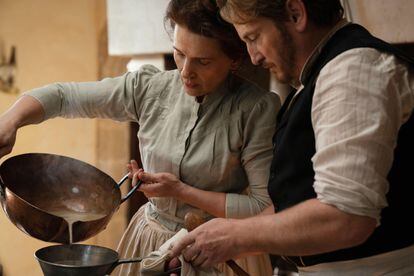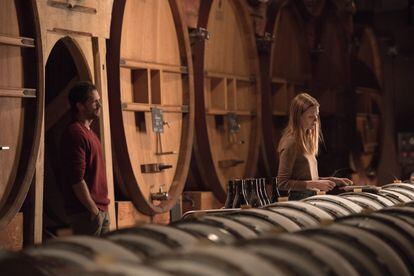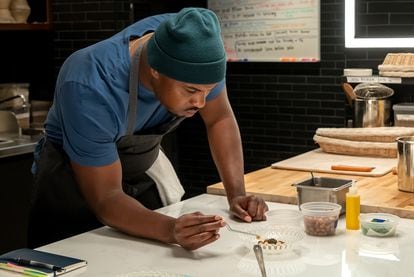When Audrey Hepburn wants to learn to cook in Sabrina, travels to France — “Paris is always a good idea,” he explains — even though he is terrible at soufflé. When Marcus (Lionel Boyce) wants to learn baking in the second season of The Bear (Disney +) — the series about a Chicago restaurant that is sweeping awards season — travels to Copenhagen. The two scenes are separated by 70 years, during which, for some experts, there has been an inexorable decline of French cuisine, cornered by new flavors, recipes and discoveries. For others—as happens to the American journalist Bill Buford in The transmission of flavor, which Anagrama has just published in translation by Rubén Martín Giráldez—French cuisine continues to be at the center of the gastronomic universe. When I had the happy idea of transmitting this debate to the members of the gastronomy section of EL PAÍS, I provoked a heated discussion and division of opinions, which reflected what is happening in kitchens and recipe books around the world.
On the one hand, there are those who believe that French food has been swallowed up by the experiments of elBulli or Noma, the great restaurant that has turned Copenhagen into the gastronomic capital of Europe, as is clear in The Bear. The greatest affront is that the character in the series is also going to learn baking, a field in which the Nordics are eating the French's toast—in the literal sense. Right now, in Madrid, bakeries offering Swedish cardamom buns are proliferating at a frenetic pace, and are beginning to endanger the kingdom of croissant, churros and ensaimadas. Some arguments put forward by critics of French gastronomy are that sauces hide flavors instead of enhancing them, and the use of cream and butter in absurd quantities in any dish, at a time when all doctors are betting on diet. Mediterranean.
But there are also staunch defenders of French cuisine, without which European gastronomy could not be conceived—nor, above all, executed. It is not just a question of flavors, but of techniques, such as the obligation for an architect or an engineer to learn elementary mathematics and the study of materials before experimenting and starting to build the Guggenheim. In France, what we know today as restaurants were invented, the Michelin guide set the pace of world gastronomy for years with its stars (although now that throne of prescription is occupied by The World's 50 Best Restaurants, where Paris does not appear until tenth place). Despite everything, if you talk about food, sooner or later you have to go through France.
Spaniards of several generations have learned to cook—and continue to do so—with the 1080 cooking recipes (Alianza Editorial), by Simone Ortega, one of the best-selling books in the history of this country. It is not just that Ortega was French, but that her great merit was, in reality, modernizing a cuisine that had been greatly affected by decades of isolation and dictatorship, like the rest of the country. And she did it through France. Chef David de Jorge explained in a post from El Comidista about Simone Ortega: “I remember that thanks to that book I was able for the first time in my life to make a sauce.” Something similar happened in the United States with Julia Child, the first television chef, protagonist of the series Julia (HBO). Her best-known book is called The art of French cuisine (Debate) and remains irreducibly among the best sellers.

The deep relationship between culture and food in France was reflected in the film Slow Fire, which Paris sent to the Oscars to compete in the best international film category, instead of Anatomy of a fall that he would have had every chance of winning if he were to compete. But, gastronomy comes first. Directed by the French-Vietnamese Tràn Anh Hùng, the first sequences of the film show Juliette Binoche working in a huge kitchen before the industrial era. There are no refrigerators, everything is fresh, cooked with wood… For lovers of French food, it is a visual feast. For its detractors, it is torture to see how a freshly caught turbot is taken out of the oven… to be subjected to all kinds of sauces loaded with cream destined to cause a paste in the stomach.
Bill Buford, an American journalist, author of a brutal book about violent football fans – Among the Vandals – who later turned to gastronomy – Heat –, wants to learn to cook like a professional and his search takes him to French restaurants and chefs. . He lands at the Bocuse institute, one of the French gastronomic temples, after working with the chef Le Cossec who teaches him, for example, how to handle a goose liver. “It is tremendously, deeply brown,” Buford writes. “And the veins are tangled. There is a long one that goes from north to south. The other goes from east to west. They intersect at some point in the northern hemisphere of the lobe.” French cuisine is not for amateurs or finicky eaters.
One of the great propagandists in the United States—and therefore, throughout the planet—of the fascination with French gastronomy was AJ Liebling (1904-1963), a magazine legend. The New Yorker, from which the Catedral publishing house rescued its classic Appetite for Paris. Memories of a 'bon vivant' (translation by Ana Isabel Sánchez; prologue by James Salter). “The first requirement to write well about food is to have an appetite,” explains the author, who longs for “the time before the First World War, when there were men and women who ate, in addition to a filling lunch and a glorious dinner, a voluminous dinner after the theater.”
They parad
e through his book bistros and Foie gras, Gascon cooks, a civet of wild boar breeding… It is an endless banquet of Asterix and Obelix. But the food that Liebling describes in a book published in the 1950s is the same as that found in traditional French restaurants (except perhaps wild boar): many times the menus have remained unchanged for decades.

One of the many subplots of the funny series about wine God's drops (Apple TV), based on a famous sleeve (Japanese comic) by Tadashi Agi and Shu Okimoto who sign under the pseudonym Tadashi Agi, is precisely about that. The series begins with the death of an imaginary character, Alexandre Léger, author of a wine guide that made him a multimillionaire. What was the secret of his success? He was the first winemaker who began to criticize the large French wineries, because he considered that they had rested on their laurels: in other countries – South Africa, Chile, Australia – they were experimenting and filling the world market with bottles, while in France they clung to increasingly older traditions.
Another classic of The New Yorker, Adam Gopnik was the one who opened the door on this controversy when he titled a famous article from 1997: 'Is there a crisis in French food?'. The text began by explaining that “for the first time in hundreds of years, people are concerned about French cuisine.” The Paris-based American writer and journalist Wendell Steavenson, author of Paris. Meter, In a report published in 2019 in The Guardian, which caused some commotion in France. She was titled 'Splendor and fall of French cuisine' and it was as provocative as it was informed.

“In 2006, after years as a journalist in the Middle East, I moved to Paris,” Steavenson writes. “It was an accidental choice. At that time I was just looking for a place to take refuge and finish a book. All my friends said: 'Oh, Paris, how beautiful! 'You must be eating very well.' They were surprised to hear me complain that Parisian menus were boring and repetitive. 'Pâté followed by nothing but entrecôte, entrecôte, entrecôte. Occasionally, roast lamb, duck breast. No vegetables,' I told them. 'It's the tyranny of meat in brown sauce.' While the rest of the world began to (re)discover their own cuisines and innovate, the French restaurant seemed stuck in a puddle of demi-glacé frozen”.
French gastronomy is part of UNESCO's Intangible Heritage of Humanity, but it is a recognition that looks to the past, not the future. It is quite a metaphor that Juliette Binoche and her kitchen did not even enter the final stretch of the best international films at the Oscars. Hollywood academics looked for other flavors and sensations. Like many gourmets.
Books, movies and series
The transmission of flavor
Bill Buford
Translation by Rubén Martín Giráldez Anagrama, 2024
541 pages. 22.90 euros
Appetite for Paris
Memories of a 'bon vivant'
AJ Liebling
Translation by Ana Isabel Sánchez Cathedral, 2022
285 pages. 21.90 euros
To simmer
Director: Tràn Anh Hùng
Released in theaters
The Bear
Second season
Director: Christopher Storer (creator),
Joanna Calo and Ramy Youssef
Disney+
God's drops
Direction: Quoc Dang Tran (creator) and Oded Ruskin
AppleTV
You can follow Babelia in Facebook and xor sign up here to receive our weekly newsletter.
Subscribe to continue reading
Read without limits
_
#tyranny #meat #brown #sauce #French #cuisine
